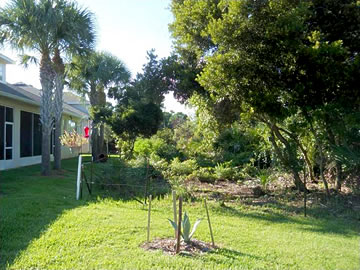A wildfire risk reduction plan is a tool that can assist property owners in maintaining conservation easements in a condition that both protects the land’s natural environmental value and nearby structures.
Public and private land managers use prescribed fire to control organic fuels, such as leaves and underbrush, that build up in natural areas. This practice lessens the fuels that could feed wildfires. St. Johns River Water Management District staff can assist land owners prepare plans and choose the right tools, such as prescribed fire, to manage land within conservation easements.
District staff is available to assist the public with preparation of wildfire risk reduction plans for property over which the District holds a conservation easement that was conveyed to the District solely for mitigation or to meet other regulatory requirements of the District or other agencies (such as the U.S. Army Corps of Engineers) as part of an application for an environmental resource permit (ERP).
Because conservation easements serve to off-set adverse impacts of development, wildfire risk reduction plans for lands within these easements may differ from plans prepared for, or approved by, other agencies. The District’s interest in measures to protect these lands from potential wildfires is balanced with what is best to maintain and protect the plant and animal species and the natural habitat within the conservation easements.



Management techniques to reduce wildfire risks include prescribed fire or mechanical measures (for example, roller chopping) to reduce fuel loads. Which tool is appropriate depends on factors such as the conditions, habitat type and location of the property. District staff can assist in developing plans and identifying tools that are suitable for various natural plant and habitat types and that are consistent with the purpose of these conservation easements and reduce the risk from potential wildfires.
District staff strongly encourage permit applicants to consider the risk of potential wildfires when designing their development project and ERP environmental mitigation plan. An ERP mitigation plan may propose suitable management measures that can sustain the ecosystems and reduce the risk of wildfire as well as addressing topics such as invasive or exotic species. District staff are available to discuss such measures during the pre-application and design review meetings.
Wildfire risk reduction plans may also be proposed within conservation easements that have already been conveyed to the District. Property owners who wish to propose measures within existing easements should consult District staff to prepare a site-specific plan and obtain written approval prior to any management activity to ensure that the activities are not contrary to the conservation easement. In this instance, there are two tools to assist landowners with easements to reduce wildfire risk: (1) interface wildfire risk reduction plan and (2) vegetation management plan.
Other reference sources to prepare a wildfire risk reduction plan include the Florida Forest Service’s (FFS) web page for firewise communities and FFS’s general wildfire information page.
With the implementation of the statewide environmental resource permitting program on Oct. 1, 2013, standard conservation easement forms were adopted by rule. These forms allow for the development of wildfire risk reduction plans subject to District approval.
To better assist those interested in obtaining approval of a wildfire risk reduction plan, the District makes sample wildfire risk reduction plan templates available. District staff will work with landowners to complete the templates. Sample templates are available for interface areas (those areas generally within 60 feet of an occupied structure) and vegetation management plans.
General wildfire risk reduction plan evaluation steps
Generally, when wildfire risk reduction activities are proposed within an existing conservation easement, the District’s wildfire risk reduction plan evaluation process will include the following steps:
- A property owner contacts the District with a request to conduct wildfire risk reduction activities.
- Staff members review the request, confirm that the area to be treated is within a conservation easement conveyed to the District, and provide the property owner with a wildfire risk reduction template. The plan may be developed in consultation with a county forester and/or District staff.
- Once a plan is developed, the property owner submits the completed plan (template) to the District with the necessary attachments, such as maps of the project area.
- District staff review the plan and conduct a site visit.
- If the plan is appropriate and does not compromise the ecological value of the conservation easement area, District staff send a letter outlining the terms and conditions for implementation of the wildfire risk reduction plan.
- If staff determine the proposed plan will reduce the ecological value of the conservation easement, District staff will work with the property owner to revise the plan. If the property owner does not wish to revise the plan, District staff would send a letter advising the property owner that a release/amendment of the conservation easement in accordance with District rules would need to be obtained before the proposed activities could proceed.

